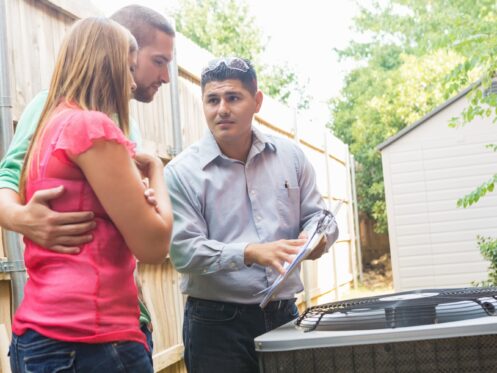You expect your air conditioner to cool the house, not build up a layer of ice inside it. Frozen AC lines catch many homeowners off guard, especially when the weather outside is scorching. This issue doesn’t mean your system has failed, but it’s not something to ignore.
If left unresolved, it can affect comfort, efficiency, and your system’s lifespan. Read this AC repair guide to learn common causes and how to fix it.
Airflow Disruptions Can Start a Freeze Chain
Frozen lines often start with airflow problems. Your AC depends on steady air movement to pull heat away from the coils. When that airflow gets blocked, the coil surface gets too cold, and condensation turns into frost. Something as simple as a dirty filter or collapsed ductwork can start the freeze. It may not seem like much, but without enough warm air passing over the coil, the refrigerant inside continues to cool. Eventually, that cold spreads back into the lines.
If you’ve skipped a few filter changes or if furniture is blocking your returns, airflow can drop quickly. Once the coil gets cold enough, ice begins to form and can spread through the lines. What looks like a surface issue may have started deep inside the system. The sooner you find the restriction and fix it, the better the outcome for your equipment.
Low Refrigerant Can Throw Everything Off
Your air conditioner needs a specific refrigerant charge to operate properly. If the system leaks or was undercharged during a past repair, the refrigerant pressure drops. Low refrigerant changes how the coil absorbs heat, which can cause it to get too cold. That change kicks off the freezing process from inside the system.
Most people don’t spot low refrigerant right away. You might notice the system running longer or cooling less effectively, but frost on the lines may be the first obvious sign. By then, the freezing has already started to interfere with airflow, which creates a feedback loop that makes the freezing worse. If you see ice and hear a hissing or bubbling sound near your outdoor unit, that could be refrigerant escaping. You’ll need a pro to find the leak, fix it properly, and recharge the system to the right level.
Dirty Coils Make Ice More Likely
Your evaporator coil sits inside the air handler, out of sight. Over time, dust, hair, and other particles build up on that surface. When the coil gets dirty, it can’t absorb heat from the air the way it should. That creates cold spots where condensation forms faster than usual, and those spots become the starting point for ice.
Even if your filter looks clean, particles still slip through and cling to the coil. Moisture from the air sticks them in place, and as that layer builds up, heat transfer slows down. If you’ve noticed uneven cooling or sudden freezing, that coil could be the issue. It’s not something you can clean with a wipe. The whole coil needs a careful cleaning to restore performance, and doing it wrong can bend the fins or damage the system. Ignoring it will only allow more buildup and more ice.
Thermostat Problems Can Contribute
If your thermostat isn’t communicating clearly with the rest of the system, it can confuse the cooling cycle. Maybe it’s running the fan constantly, even when the compressor shuts off. Maybe it’s calling for cooling at the wrong temperature. Both situations can throw off the balance between heat absorption and refrigerant actions.
When your system runs too long without rest or tries to cool air that’s already chilled, the evaporator coil stays colder than it should. That cold creates the perfect environment for freezing, especially on humid days. If your thermostat is old, battery-powered, or mounted in a bad spot, such as near a window, it may not give accurate readings. Sometimes, the fix is a simple recalibration. Other times, a modern programmable thermostat can help you keep better control of system cycling and prevent the overcooling that leads to ice buildup.
Condensate Drain Problems Can Lead to Frost
Your AC doesn’t just cool the air. It also removes moisture. That moisture drips off the evaporator coil into a drain pan and exits through a drain line. If the line gets clogged, water backs up. That standing water collects around the coil and can freeze when the refrigerant gets too cold.
At first, the frozen water might affect the pan or a small section of the line. As the system continues to run, though, ice builds around the coil and then spreads through the copper refrigerant lines. You may hear dripping or notice water stains near the unit. You might even smell a musty odor from the trapped moisture. Once the line is cleared, the system will stop producing extra ice, but if the coil stays frozen too long, it can warp or corrode.
Running the System Constantly Makes Things Worse
If you’ve been setting your thermostat low and letting the system run non-stop, you could be accelerating the freezing. Long cycles, especially when airflow is low or refrigerant is off, mean the coil doesn’t get time to thaw. That ice just keeps spreading with each hour the unit runs.
Some people crank the air conditioner during extreme heat, thinking they’re helping the house stay cool. What happens is that the system runs flat out, the coil never warms up, and the temperature keeps falling inside the air handler. Eventually, even the return line leading back outside can freeze. When that happens, the system can’t move refrigerant efficiently and may shut off on its own as a safety measure. Giving the unit time to rest and adjusting your thermostat gradually can help prevent runaway icing.
What Melts the Ice Isn’t Always Obvious
A frozen system won’t thaw out with just a warm day. The coil is insulated by all that ice, which means heat from the air can’t get to it. Even turning off the system may not help quickly if the ice is thick. You’ll need to keep the fan running without cooling mode active to circulate air across the coil. That speeds up the melt.
Once the ice is gone, though, don’t assume the problem has fixed itself. The underlying cause is still there whether it was a clog, dirty coil, or low refrigerant. Running the system again without addressing it will trigger the next freeze. It’s worth having the system inspected by an HVAC service expert while it’s thawed so that you don’t end up chasing a repeating issue.
Schedule Your AC Visit and Stay Cool
If your AC lines keep freezing, there’s always a reason. Maybe it’s a simple clog. Maybe it’s a deeper airflow or refrigerant issue. Whatever the root cause, the solution starts with getting ahead of it instead of guessing. Alongside air conditioner repair and refrigerant diagnostics, George’s Air Conditioning also provides maintenance and airflow assessments to help you stay ahead of future issues.
Schedule a visit with George’s Air Conditioning in Texas City, TX today and get your system back on track.



